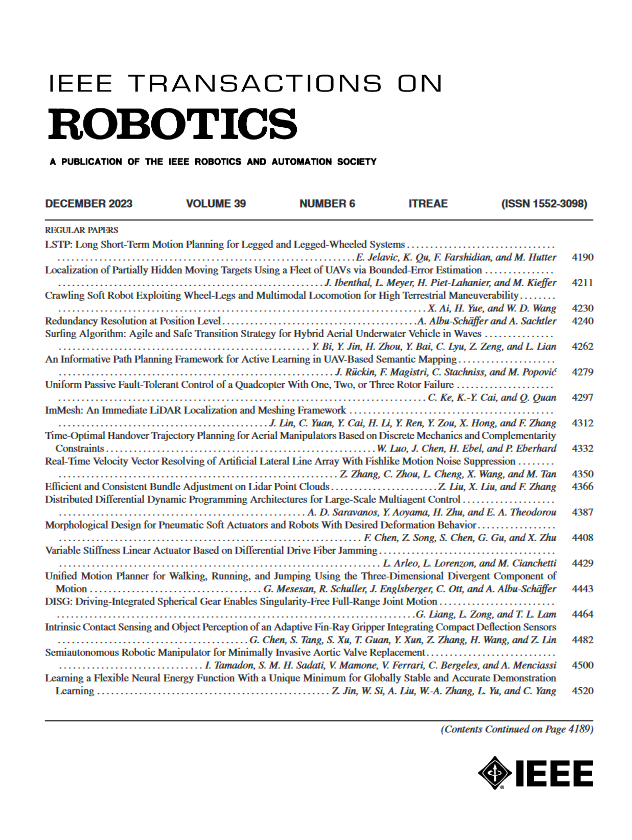软机器人预测身体感知:融合多模态感官数据的贝叶斯变分自编码器
IF 10.5
1区 计算机科学
Q1 ROBOTICS
引用次数: 0
摘要
融合多模态感知预测因果流是构建软机器人身体意识的基础。然而,在融合软机器人的多模态感官数据的同时形成这样的预测模型仍然具有挑战性,并且探索较少。在这项研究中,我们利用贝叶斯概率深度学习框架中的自由能原理来合并视觉、压力和弯曲传感信号。我们提出的多模态关联机制增强了融合过程,建立了稳健的计算方法。我们使用新收集的数据集来训练模型,该数据集捕获了具有多模态感知能力的软夹持器的抓取动态。通过结合当前状态和图像差异,前向模型可以预测软爪在图像流中的物理交互和运动,相当于想象未来的运动事件。此外,我们展示了跨模式的有效预测以及对结果的把握。值得注意的是,我们增强的变分自编码器方法可以为软机器人中前所未有的身体意识可能性铺平道路。本文章由计算机程序翻译,如有差异,请以英文原文为准。
Predictive Body Awareness in Soft Robots: A Bayesian Variational Autoencoder Fusing Multimodal Sensory Data
Predicting the causal flow by fusing multimodal perception is fundamental for constructing the bodily awareness of soft robots. However, forming such a predictive model while fusing the multimodal sensory data of soft robots remains challenging and less explored. In this study, we leverage the free energy principle within a Bayesian probabilistic deep learning framework to merge visual, pressure, and flex sensing signals. Our proposed multimodal association mechanism enhances the fusion process, establishing a robust computational methodology. We train the model using a newly collected dataset that captures the grasping dynamics of a soft gripper equipped with multimodal perception capabilities. By incorporating the current state and image differences, the forward model can predict the soft gripper’s physical interaction and movement in the image flow, which amounts to imagining future motion events. Moreover, we showcase effective predictions across modalities as well as for grasping outcomes. Notably, our enhanced variational autoencoder approach can pave the way for unprecedented possibilities of bodily awareness in soft robotics.
求助全文
通过发布文献求助,成功后即可免费获取论文全文。
去求助
来源期刊

IEEE Transactions on Robotics
工程技术-机器人学
CiteScore
14.90
自引率
5.10%
发文量
259
审稿时长
6.0 months
期刊介绍:
The IEEE Transactions on Robotics (T-RO) is dedicated to publishing fundamental papers covering all facets of robotics, drawing on interdisciplinary approaches from computer science, control systems, electrical engineering, mathematics, mechanical engineering, and beyond. From industrial applications to service and personal assistants, surgical operations to space, underwater, and remote exploration, robots and intelligent machines play pivotal roles across various domains, including entertainment, safety, search and rescue, military applications, agriculture, and intelligent vehicles.
Special emphasis is placed on intelligent machines and systems designed for unstructured environments, where a significant portion of the environment remains unknown and beyond direct sensing or control.
 求助内容:
求助内容: 应助结果提醒方式:
应助结果提醒方式:


